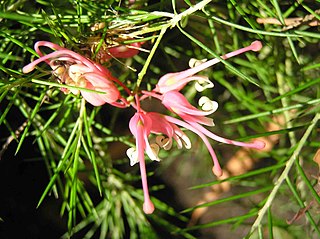
Grevillea miniata, commonly known as sandstone grevillea, is a species of flowering plant in the family Proteaceae and is endemic to north-western Australia. It is a spreading to erect shrub or small tree with more or less oblong leaves and bright yellow to orange and bright red flowers with a yellow style.

Grevillea humifusa, commonly known as spreading grevillea, is a species of flowering plant in the family Proteaceae and is endemic to a restricted area of the south-west of Western Australia. It is a prostrate shrub with long, trailing stems, divided lives with linear lobes and clusters of pink to pale red and cream-coloured flowers with a reddish, yellow-tipped style.

Grevillea olivacea, commonly known as olive grevillea, is a species of flowering plant in the family Proteaceae and is endemic to the west coast of Western Australia. It is a dense, erect shrub with elliptic to egg-shaped leaves, and erect clusters of bright red and orange or yellow flowers with a red to yellow style.

Grevillea didymobotrya is a species of flowering plant in the family Proteaceae and is endemic to the south-west of Western Australia. It is an erect shrub with simple leaves, the size and shape depending on subspecies, and cylindrical groups of yellow or cream-coloured flowers.

Grevillea miqueliana is a species of flowering plant in the family Proteaceae and is endemic to Victoria in Australia. It is an erect to spreading shrub with elliptic to egg-shaped leaves and clusters of red and orange or yellow flowers.

Grevillea infundibularis, commonly known as fan-leaf grevillea, is a species of flowering plant in the family Proteaceae and is endemic to a restricted area in the south of Western Australia. It is a spreading to low-lying shrub with egg-shaped to hemispherical leaves and clusters of four to eight bright red flowers.

Grevillea plurijuga is a species of flowering plant in the family Proteaceae and is endemic to southern Western Australia. It is a prostrate to low-lying or dense mounded to erect shrub with divided leaves with linear lobes and loose clusters of hairy, red or pink flowers.

Grevillea evanescens is a species of flowering plant in the family Proteaceae and is endemic to the south-west of Western Australia. It is an erect to spreading shrub with oblong to elliptic leaves and clusters of pale to bright red and cream-coloured flowers.

Grevillea granulosa is a species of flowering plant in the family Proteaceae and is endemic to the south-west of Western Australia. It is a low, spreading shrub with linear leaves and red to orange flowers in clusters of up to eight.
Grevillea nematophylla, commonly known as water bush or silver-leaved water bush, is a species of flowering plant in the family Proteaceae and is endemic to Australia. It is shrub or small tree with simple or pinnatisect leaves, the leaves or lobes linear, and branched, cylindrical clusters of cream-coloured flowers.

Grevillea fasciculata is a species of flowering plant in the family Proteaceae and is endemic to the south-west of Western Australia. It is a low, often spreading shrub with narrowly elliptic to more or less linear leaves and erect clusters of red and orange or orange and yellow flowers.

Grevillea candolleana, commonly known as the Toodyay grevillea, is a species of flowering plant in the family Proteaceae and is endemic to a restricted part of the south-west of Western Australia. It is a shrub with narrow egg-shaped to linear leaves and white to cream-coloured flowers.

Grevillea deflexa is a species of flowering plant in the family Proteaceae and is endemic to inland areas of central Western Australia. It is a shrub with linear to elliptic or egg-shaped leaves, and groups of red, yellow or red and yellow flowers.

Grevillea erythroclada, commonly called needle-leaf grevillea, is a species of flowering plant in the family Proteaceae and is endemic to northern Australia. It is a shrub or small tree with divided leaves, the ultimate lobes linear to more or less cylindrical, and clusters of cream-coloured to pale yellow flowers.

Grevillea florida is a species of flowering plant in the family Proteaceae and is endemic to the south-west of Western Australia. It is a erect, low shrub with linear to narrowly elliptic leaves, and clusters of hairy, white to creamy yellow flowers with a yellow- or orange-tipped style that ages to red.

Grevillea gordoniana is a species of flowering plant in the family Proteaceae and is endemic to the west of Western Australia. It is an erect shrub or small tree with cylindrical leaves and yellow to orange flowers.

Grevillea muelleri is a species of flowering plant in the family Proteaceae and is endemic to the a relatively small area of south-western Western Australia. It is a shrub with linear to narrowly oblong, or divided leaves with linear or narrowly egg-shaped lobes, more or less spherical clusters of white to cream-coloured flowers.

Grevillea oligantha is a species of flowering plant in the family Proteaceae and is endemic to southern Western Australia. It is dense shrub with many erect branches, egg-shaped, lance-shaped or linear leaves, and groups of up to six brownish-yellow, orange or reddish-brown flowers with a pale yellow to reddish style.

Grevillea patentiloba is a species of flowering plant in the family Proteaceae and is endemic to the south-west of Western Australia. It is a prostrate to erect, spreading to straggling shrub with divided leaves, and down-turned clusters of red to deep pink and cream-coloured to bright yellow flowers with a red to deep pink style.

Grevillea pauciflora, commonly known as the few-flowered grevillea, or as Port Lincoln grevillea in South Australia, is a species of flowering plant in the family Proteaceae and is endemic to the south of continental Australia. It is an erect to straggly or spreading shrub with linear to narrowly wedge-shaped leaves and red or orange flowers with a red or orange style.




















